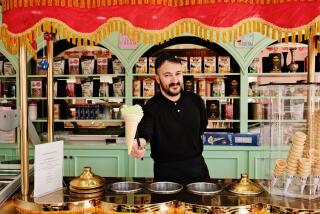Java or Gelato, It’s Tasters’ Choice : Flavor Developers Take a Cold, Hard Look at What Makes Good Ice Cream
- Share via
John Harrison, official taster for Dreyer’s Grand Ice Cream Inc., describes his occupation as the “Willy Wonka job of America.”
A fourth-generation ice cream man and 18-year veteran of Dreyer’s, Harrison has developed about 75 flavors for the company. But he is best known for Cookies ‘N Cream, now the fourth-best-selling ice cream flavor in the nation.
Ice cream companies survive on the strength of new flavors and the consistency of their product. And so they depend on a cadre of trained professionals to develop and test winning formulas, to monitor manufacturing so that cartons have perfectly distributed swirls of chocolate and cookie chunks, and to visit supermarkets to see that product quality is still high when it reaches the freezer case.
It’s a tough job, but somebody’s got to do it.
One day in 1982, Harrison was on a break from the laboratory and snacking on his favorite vanilla ice cream in the Oakland-based company’s Grand Avenue ice cream parlor. A couple of cookies served on the side caught his eye.
“I thought, ‘We’re living in a world of convenience, drive-in food, drive-in banks--why don’t I save a step and put the cookie in the ice cream?’ ” Harrison says.
A new flavor was born--and the marketing department let out a big ho-hum. Too childish, they said, and filed it away.
Six months later, a freak hailstorm destroyed the Fresno peach crop and necessitated a quick replacement for the company’s peaches and cream flavor.
“Marketing decided to try the Cookies ‘N Cream for 90 days and see what happens,” Harrison says. “And as Paul Harvey would say, now you know the rest of the story.”
Cookies ‘N Cream--with a dozen Oreos mixed into each half-gallon of vanilla--was launched in 1983 and became the company’s fastest-growing flavor ever.
Today Dreyer’s is a much bigger company, with $1 billion in sales, and the marketing department is the place where most new flavor concepts are born. The 35-member research and development team makes the requested prototypes and turns them back over to marketing for testing and evaluation.
“It may take anywhere from six to 15 different trips back and forth from R&D; to marketing until they say, ‘That’s exactly what we have in mind; let’s lock it in right there,’ ” Harrison says.
Once the company’s only ice cream flavor developer, Harrison now travels up to eight months a year supervising tasters in each of the company’s six manufacturing plants and visiting supermarkets to sample the product. (The ice cream is sold as Edy’s Grand east of the Rockies to avoid confusion with rival Breyers, which has strong name recognition there.)
He’s also the company’s public face, giving in-store consumer tastings as he goes along. He carries with him a special double-handled ice cream knife to cut cartons in half and a gold-plated spoon that imparts no flavor during sampling.
The company likes to promote the fact that it has insured Harrison’s taste buds for $1 million.
What he looks for in his tastings are an appetizing appearance; a flavorful balance between dairy, sugar and added ingredients; and a smooth and creamy texture.
As one of Ben & Jerry’s Homemade Inc.’s four ice cream flavor developers, Eric Fredette gets to share his love of nuts with others, in the form of rich frozen confections.
One of his most recent creations is Dilbert’s World--Totally Nuts, a butter almond ice cream packed with roasted hazelnuts, praline pecans and white fudge-covered almonds that delivers a whopping 84 grams of fat in each pint-size carton.
Fredette had to taste a lot of nuts and ice cream before he arrived at the perfect blend of ingredients for his new Ben & Jerry’s flavor. In fact, Fredette often spends as many as four to five hours each day tasting ice cream that he and the others develop.
During the busy January new-product season, when they are coming up with flavors for the following year, he can sample as many as 20 flavors in a two-hour period.
Could there be a better job for someone with a discriminating palate, a love of food and a sweet tooth that won’t quit? And one paying $25,000 to $65,000 or more annually to boot, according to “Nice Job: The Guide to Cool, Odd, Risky and Gruesome Ways to Make a Living,” by Jamie Rosen (Ten Speed Press, 1999) and companies surveyed.
Fredette, who also develops novelty items such as pops, bars and sandwiches, doesn’t think so. He and his co-workers, self-described “foodies” with degrees in culinary arts and experience in restaurant cooking, think they have it made.
“We play with our food all day. I enjoy it immensely,” Fredette says.
At Pillsbury Co. in Minneapolis, where annual sales of its Haagen-Dazs ice cream are also at $1 billion, the process for developing new ice cream flavors is tightly structured.
The marketing department, which bases most of its new flavors on consumer trends and preferences, recently struck gold trying to reach the Latino consumer with its new Dulce de Leche caramel ice cream, now the company’s No. 2 flavor after vanilla and a crossover hit.
*
The R&D; department’s food scientists, who know their chemistry but aren’t experts in evaluating flavors, come up with formulas to match the marketing department requests and sometimes experiment with flavor combinations of their own.
Prototypes are served to the company’s part-time sensory evaluators, ordinary people selected for their sensitive taste buds and enjoyment of food. To test their taste acuity, the company has them identify blind samples.
“We give them solutions of water with salt versus sugar, and they have to be able to tell us one’s sweet and one’s salty,” says Nancy Eicher, sensory evaluation director. “We give them jars with smells on little slips of paper, and they have to be able to tell us, this one is lemon, that one is orange--which is an amazingly difficult task because those two are very close together.”
These part-time workers receive four to six months of training in food terminology and characteristics and each week are given blind samples of Pillsbury products ranging from ice cream to pizza to canned peas.
Evaluators sample the products cloistered in individual booths and describe the taste and texture qualities, noting which flavors are more dominant, if a product is creamy or icy, sweet or sour.
After consumers have tasted the prototypes and told the company which they prefer, the evaluators’ data help chemists re-create the samples that consumers liked best.
At Ben & Jerry’s, a $210-million company, flavor developers have a freer hand to create new items based on their own tastes.
“It usually starts with an inspiration,” Fredette says, “whether it’s a dessert I had in a restaurant when I was traveling in Chicago or something that caught my eye at the local supermarket or fresh produce when it’s in season.”
Developers shop for ingredients at local stores, bake their own cookie pieces and custom-order ingredients from suppliers around the country.
When a test batch of a new flavor is completed, a tasting session is convened around the huge R&D; test kitchen island, with as many as 14 staff members digging their spoons into a communal pint and offering comments as it’s passed around.
“We’re very close here,” Fredette says by way of explanation.
A lot of the flavors go right into the garbage, but testers will sample even those that are really bad. “You have to know how disgusting it is,” he says.
When they’re doing a marathon tasting, developers drink lots of water and use bread to clean the palate. They’ll start with mild flavors such as vanilla, and progress up through fruit, chocolate, coffee and mint.
After a flavor has been given the thumbs up, it is turned over to consumers for their input. If it passes muster, a name and packaging are chosen.
The developer works out the production details with staff engineers, specifying everything from the number of nuts in a carton to the pattern of the swirls.
During the spring production season, a long workday can get even more intense as developers visit the manufacturing plant to sample product through the night.
*
Do the pros ever get tired of all this ice cream or gain a dangerous amount of weight? They insist they don’t. Thanks to the tasting technique of swirl, smack and spit, they don’t necessarily swallow that much product.
And at Pillsbury, they say the variety of foods they taste keeps them fresh. Dreyer’s Harrison says that after all these years, he’s got butterfat in his blood.
Ben & Jerry’s assists all its employees with free gym memberships to offset the three free pints of ice cream each receives every day.
But a couple of people have suffered ice cream fatigue--Fredette’s two young children. “My kids don’t really eat ice cream anymore. The thrill is gone for them,” he says.
At least until the ice cream man comes around their neighborhood in his truck. “Then they have to have an ice pop,” Fredette says, “you know, something blue.”
New flavors may come and go, but some things never change.
More to Read
Eat your way across L.A.
Get our weekly Tasting Notes newsletter for reviews, news and more.
You may occasionally receive promotional content from the Los Angeles Times.











